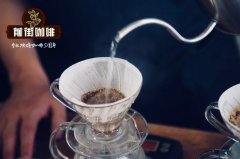Arabica Coffee how do you drink Arabica Coffee? why do you use Arabica for most coffee?

Professional coffee knowledge exchange more coffee bean information please follow the coffee workshop (Wechat official account cafe_style)
At present, there are more than 100 kinds of coffee in the world, of which two of the most common are Arabica and Robusta/Canephora. These two kinds of coffee are very different in taste, composition and growing conditions. We will compare the differences between them below.
Arabica: expensive, supple taste, low caffeine
Coffee advertisements often emphasize that they use 100% Arabica coffee. Yes, in terms of price alone, Arabica is indeed more advanced, the average price of Arabica coffee beans is twice that of Robusta.
In terms of composition, Arabica has low caffeine (0.9-1.2%), 60% more fat and twice as much sugar, so taken together, Arabica tastes sweet and soft, with a plum-like sour taste.
In addition, Arabica has lower chlorogenic acid (5.5-8%), and chlorogenic acid is not only antioxidant, but also an important component of resistance to pests, so Arabica is more vulnerable to insects and climate, generally planted at higher elevations, bearing less fruit and slower. The fruit is oval.
At present, Brazil is the largest grower of Arabica, while Colombia produces only Arabica coffee.
The flavor of coffee
Acidity (acidity): the stimulation felt at the edge of the tongue when drinking coffee. Unlike the acid of lemon, coffee is a refreshing, refreshing feeling that boosts the taste, sometimes called brightness. Acidity is a very important characteristic of coffee, coffee without acidity will be very insipid.
Aroma: the aroma of brewed coffee is more varied than that felt by the tongue. The adjectives commonly used to describe the aroma of coffee are fruit-like, earthy, smoky, flowery, berries, nuts and so on.
Body: the taste of coffee in the mouth, from light as water or skim milk to thick as milk or cream, syrup.
Aftertaste: similar to the concept of wine tasting, refers to the taste that remains in the mouth after drinking coffee. Some coffee has the aftertaste of cocoa or chocolate, while others have fruit, berries, nuts and so on.
Balance (balance): this is an assessment of the overall taste of coffee. Good beans have a balanced, layered, and soft aroma, while bad beans usually show a single flavor.
In addition to the above proper nouns, there are several common adjectives that describe high-quality coffee:
Mellow: coffee with low to medium acidity and good balance.
Mild: indicates that coffee has a harmonious and delicate flavor
Soft: coffee with a low acidity and a sweet taste
Arabica produces less caffeine because it grows at a higher altitude and generally has fewer pests.
People are more receptive to the flavor of Arabica beans because Arabica is rich in aroma, and it is also easy to be affected by different elevations, soils, climatic conditions, and other factors that affect the growth and flavor of Arabica beans, so although they are all called Arabica, people from different places will have very different tastes.
In contrast, Robusta has more personality and is not easy to change its flavor by external factors, so there is little difference in flavor among Robusta in different producing areas. In addition, some coffee fans prefer sour coffee, while others prefer bitter coffee. In this part, Arabica beans are usually highly sour, while Robusta has a strong bitter taste.
Although Robusta's coffee production is much less than that of Arabica, it is not more expensive, but cheaper. The reason is that Robusta is easier to plant, in other words, the survival rate is higher.
Robuska is more resistant to disease than Arabica, so it is not easily affected by differences in climate or soil.
Important Notice :
前街咖啡 FrontStreet Coffee has moved to new addredd:
FrontStreet Coffee Address: 315,Donghua East Road,GuangZhou
Tel:020 38364473
- Prev

Are Arabica coffee beans black coffee beans specialize in Arabica?
More information about coffee beans Please follow the Coffee Workshop (official Wechat account cafe_style) there are more than 100 kinds of coffee in the world, two of which are Arabica and Robusta/Canephora. These two kinds of coffee are quite different in taste, composition and planting conditions. We will compare the two kinds of coffee below.
- Next

How about Yunnan coffee? What is Yunnan Coffee Iron truck? Yunnan Tieka coffee flavor
Professional coffee knowledge exchange more coffee bean information Please follow the coffee workshop (official Wechat account cafe_style) more than a hundred years ago, French missionaries brought the first coffee seed to Pu'er, Yunnan to be planted. Nowadays, the every move of Yunnan coffee attracts the attention of the world. At present, the planting area of coffee in Yunnan Province is more than 1.8 million mu, and the annual output of raw coffee beans is more than 150000 tons, accounting for the whole.
Related
- Beginners will see the "Coffee pull flower" guide!
- What is the difference between ice blog purified milk and ordinary milk coffee?
- Why is the Philippines the largest producer of crops in Liberia?
- For coffee extraction, should the fine powder be retained?
- How does extracted espresso fill pressed powder? How much strength does it take to press the powder?
- How to make jasmine cold extract coffee? Is the jasmine + latte good?
- Will this little toy really make the coffee taste better? How does Lily Drip affect coffee extraction?
- Will the action of slapping the filter cup also affect coffee extraction?
- What's the difference between powder-to-water ratio and powder-to-liquid ratio?
- What is the Ethiopian local species? What does it have to do with Heirloom native species?

